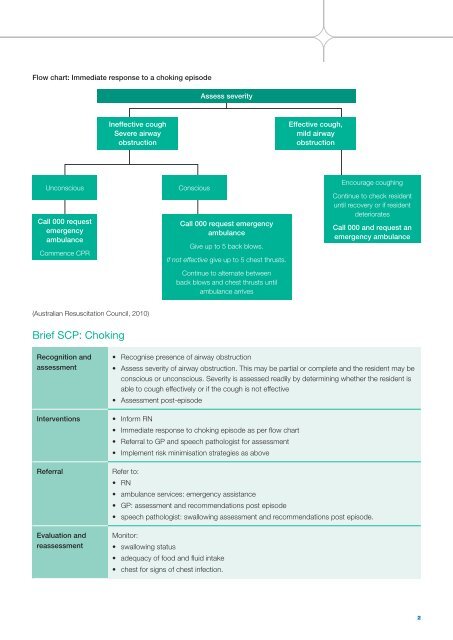Standardised care process - choking (138kb, pdf) - Department of ...
Standardised care process - choking (138kb, pdf) - Department of ...
Standardised care process - choking (138kb, pdf) - Department of ...
Create successful ePaper yourself
Turn your PDF publications into a flip-book with our unique Google optimized e-Paper software.
Flow chart: Immediate response to a <strong>choking</strong> episode<br />
Assess severity<br />
Ineffective cough<br />
Severe airway<br />
obstruction<br />
Effective cough,<br />
mild airway<br />
obstruction<br />
Unconscious<br />
Call 000 request<br />
emergency<br />
ambulance<br />
Commence CPR<br />
Conscious<br />
Call 000 request emergency<br />
ambulance<br />
Give up to 5 back blows.<br />
If not effective give up to 5 chest thrusts.<br />
Continue to alternate between<br />
back blows and chest thrusts until<br />
ambulance arrives<br />
Encourage coughing<br />
Continue to check resident<br />
until recovery or if resident<br />
deteriorates<br />
Call 000 and request an<br />
emergency ambulance<br />
(Australian Resuscitation Council, 2010)<br />
Brief SCP: Choking<br />
Recognition and<br />
assessment<br />
Interventions<br />
Referral<br />
Evaluation and<br />
reassessment<br />
• Recognise presence <strong>of</strong> airway obstruction<br />
• Assess severity <strong>of</strong> airway obstruction. This may be partial or complete and the resident may be<br />
conscious or unconscious. Severity is assessed readily by determining whether the resident is<br />
able to cough effectively or if the cough is not effective<br />
• Assessment post-episode<br />
• Inform RN<br />
• Immediate response to <strong>choking</strong> episode as per fl ow chart<br />
• Referral to GP and speech pathologist for assessment<br />
• Implement risk minimisation strategies as above<br />
Refer to:<br />
• RN<br />
• ambulance services: emergency assistance<br />
• GP: assessment and recommendations post episode<br />
• speech pathologist: swallowing assessment and recommendations post episode.<br />
Monitor:<br />
• swallowing status<br />
• adequacy <strong>of</strong> food and fl uid intake<br />
• chest for signs <strong>of</strong> chest infection.<br />
2
















